Analyzing Big Data Applications in the Oil and Gas Industry Today
VerifiedAdded on 2023/05/28
|9
|2762
|484
Essay
AI Summary
This essay examines the application of big data within the oil and gas industry, focusing on its characteristics, including volume, variety, velocity, and variability. It discusses how big data technologies are used to improve drilling processes, production performance, and address safety and environmental concerns. The essay also explores the future potential of big data in areas such as demand prediction, hydrocarbon deposit analysis, and automation of drilling processes. Furthermore, it addresses the ethical implications associated with the use of big data, emphasizing the importance of data privacy, security, and transparency. The analysis reveals that while the adoption of big data analytics in the oil and gas industry is still in its early stages, it holds significant promise for optimizing operations and enhancing decision-making.

Running head: BIG DATA
Big Data
[Name of the Student]
[Name of the University]
[Author note]
Big Data
[Name of the Student]
[Name of the University]
[Author note]
Paraphrase This Document
Need a fresh take? Get an instant paraphrase of this document with our AI Paraphraser
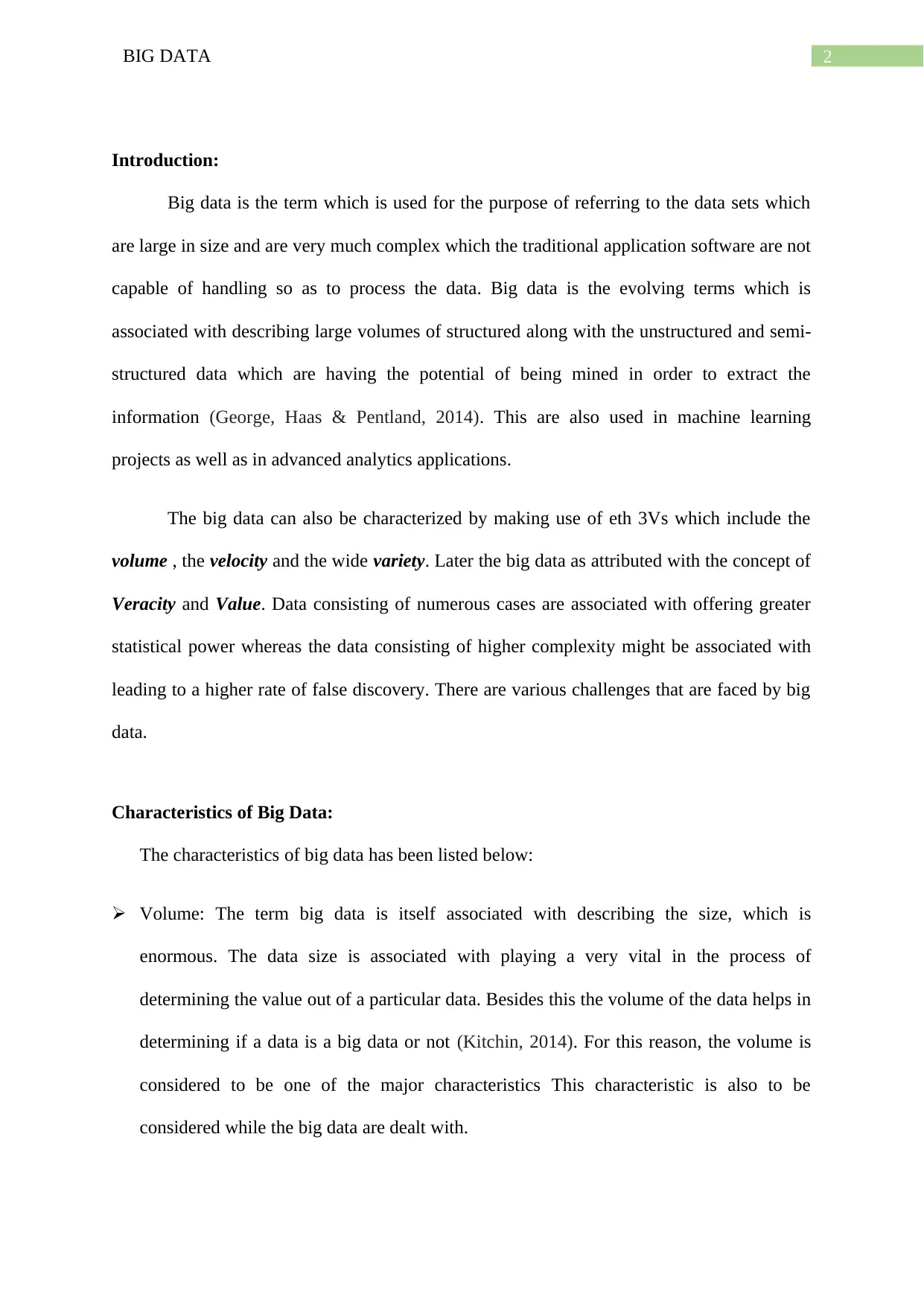
2BIG DATA
Introduction:
Big data is the term which is used for the purpose of referring to the data sets which
are large in size and are very much complex which the traditional application software are not
capable of handling so as to process the data. Big data is the evolving terms which is
associated with describing large volumes of structured along with the unstructured and semi-
structured data which are having the potential of being mined in order to extract the
information (George, Haas & Pentland, 2014). This are also used in machine learning
projects as well as in advanced analytics applications.
The big data can also be characterized by making use of eth 3Vs which include the
volume , the velocity and the wide variety. Later the big data as attributed with the concept of
Veracity and Value. Data consisting of numerous cases are associated with offering greater
statistical power whereas the data consisting of higher complexity might be associated with
leading to a higher rate of false discovery. There are various challenges that are faced by big
data.
Characteristics of Big Data:
The characteristics of big data has been listed below:
Volume: The term big data is itself associated with describing the size, which is
enormous. The data size is associated with playing a very vital in the process of
determining the value out of a particular data. Besides this the volume of the data helps in
determining if a data is a big data or not (Kitchin, 2014). For this reason, the volume is
considered to be one of the major characteristics This characteristic is also to be
considered while the big data are dealt with.
Introduction:
Big data is the term which is used for the purpose of referring to the data sets which
are large in size and are very much complex which the traditional application software are not
capable of handling so as to process the data. Big data is the evolving terms which is
associated with describing large volumes of structured along with the unstructured and semi-
structured data which are having the potential of being mined in order to extract the
information (George, Haas & Pentland, 2014). This are also used in machine learning
projects as well as in advanced analytics applications.
The big data can also be characterized by making use of eth 3Vs which include the
volume , the velocity and the wide variety. Later the big data as attributed with the concept of
Veracity and Value. Data consisting of numerous cases are associated with offering greater
statistical power whereas the data consisting of higher complexity might be associated with
leading to a higher rate of false discovery. There are various challenges that are faced by big
data.
Characteristics of Big Data:
The characteristics of big data has been listed below:
Volume: The term big data is itself associated with describing the size, which is
enormous. The data size is associated with playing a very vital in the process of
determining the value out of a particular data. Besides this the volume of the data helps in
determining if a data is a big data or not (Kitchin, 2014). For this reason, the volume is
considered to be one of the major characteristics This characteristic is also to be
considered while the big data are dealt with.
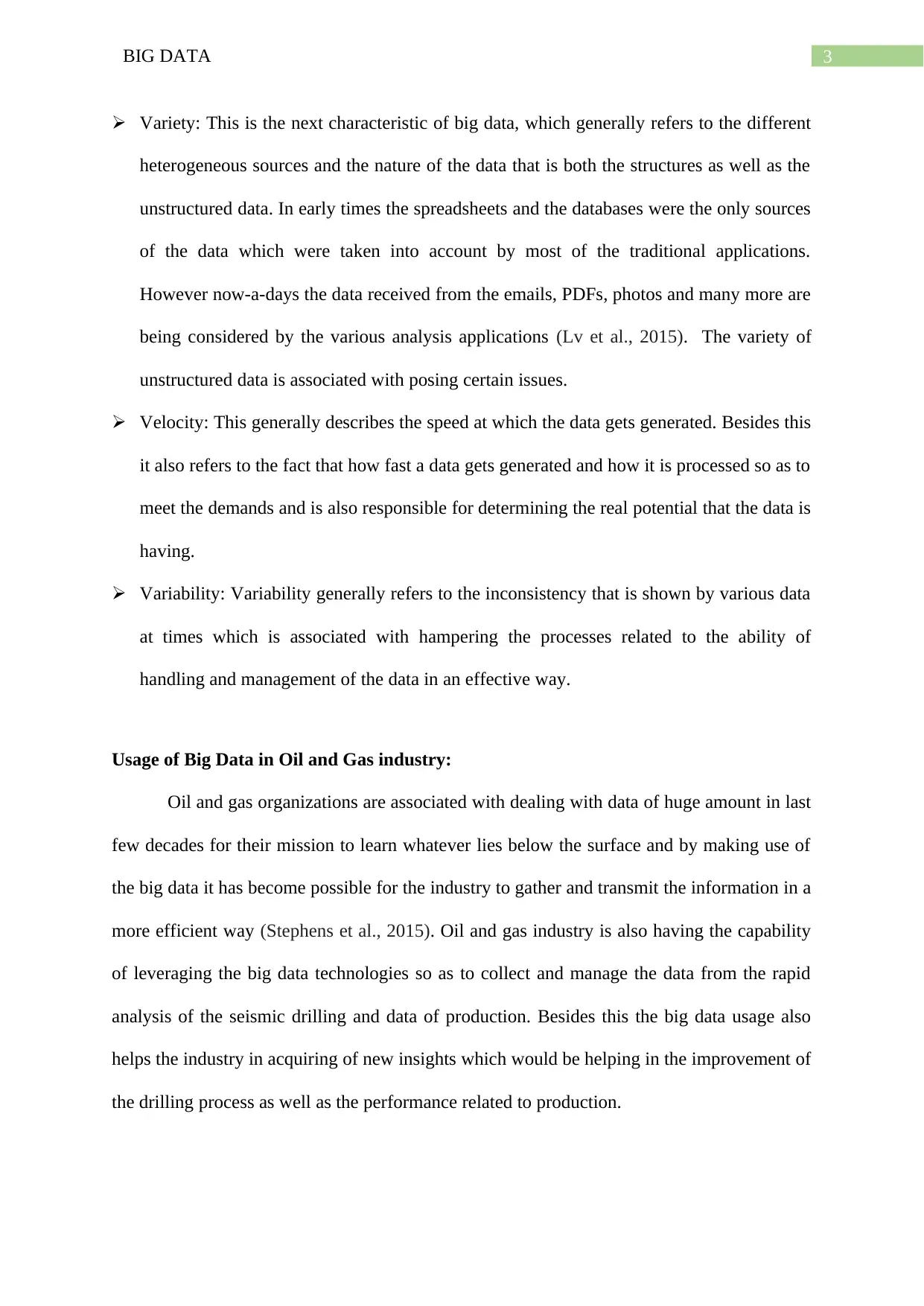
3BIG DATA
Variety: This is the next characteristic of big data, which generally refers to the different
heterogeneous sources and the nature of the data that is both the structures as well as the
unstructured data. In early times the spreadsheets and the databases were the only sources
of the data which were taken into account by most of the traditional applications.
However now-a-days the data received from the emails, PDFs, photos and many more are
being considered by the various analysis applications (Lv et al., 2015). The variety of
unstructured data is associated with posing certain issues.
Velocity: This generally describes the speed at which the data gets generated. Besides this
it also refers to the fact that how fast a data gets generated and how it is processed so as to
meet the demands and is also responsible for determining the real potential that the data is
having.
Variability: Variability generally refers to the inconsistency that is shown by various data
at times which is associated with hampering the processes related to the ability of
handling and management of the data in an effective way.
Usage of Big Data in Oil and Gas industry:
Oil and gas organizations are associated with dealing with data of huge amount in last
few decades for their mission to learn whatever lies below the surface and by making use of
the big data it has become possible for the industry to gather and transmit the information in a
more efficient way (Stephens et al., 2015). Oil and gas industry is also having the capability
of leveraging the big data technologies so as to collect and manage the data from the rapid
analysis of the seismic drilling and data of production. Besides this the big data usage also
helps the industry in acquiring of new insights which would be helping in the improvement of
the drilling process as well as the performance related to production.
Variety: This is the next characteristic of big data, which generally refers to the different
heterogeneous sources and the nature of the data that is both the structures as well as the
unstructured data. In early times the spreadsheets and the databases were the only sources
of the data which were taken into account by most of the traditional applications.
However now-a-days the data received from the emails, PDFs, photos and many more are
being considered by the various analysis applications (Lv et al., 2015). The variety of
unstructured data is associated with posing certain issues.
Velocity: This generally describes the speed at which the data gets generated. Besides this
it also refers to the fact that how fast a data gets generated and how it is processed so as to
meet the demands and is also responsible for determining the real potential that the data is
having.
Variability: Variability generally refers to the inconsistency that is shown by various data
at times which is associated with hampering the processes related to the ability of
handling and management of the data in an effective way.
Usage of Big Data in Oil and Gas industry:
Oil and gas organizations are associated with dealing with data of huge amount in last
few decades for their mission to learn whatever lies below the surface and by making use of
the big data it has become possible for the industry to gather and transmit the information in a
more efficient way (Stephens et al., 2015). Oil and gas industry is also having the capability
of leveraging the big data technologies so as to collect and manage the data from the rapid
analysis of the seismic drilling and data of production. Besides this the big data usage also
helps the industry in acquiring of new insights which would be helping in the improvement of
the drilling process as well as the performance related to production.
⊘ This is a preview!⊘
Do you want full access?
Subscribe today to unlock all pages.

Trusted by 1+ million students worldwide
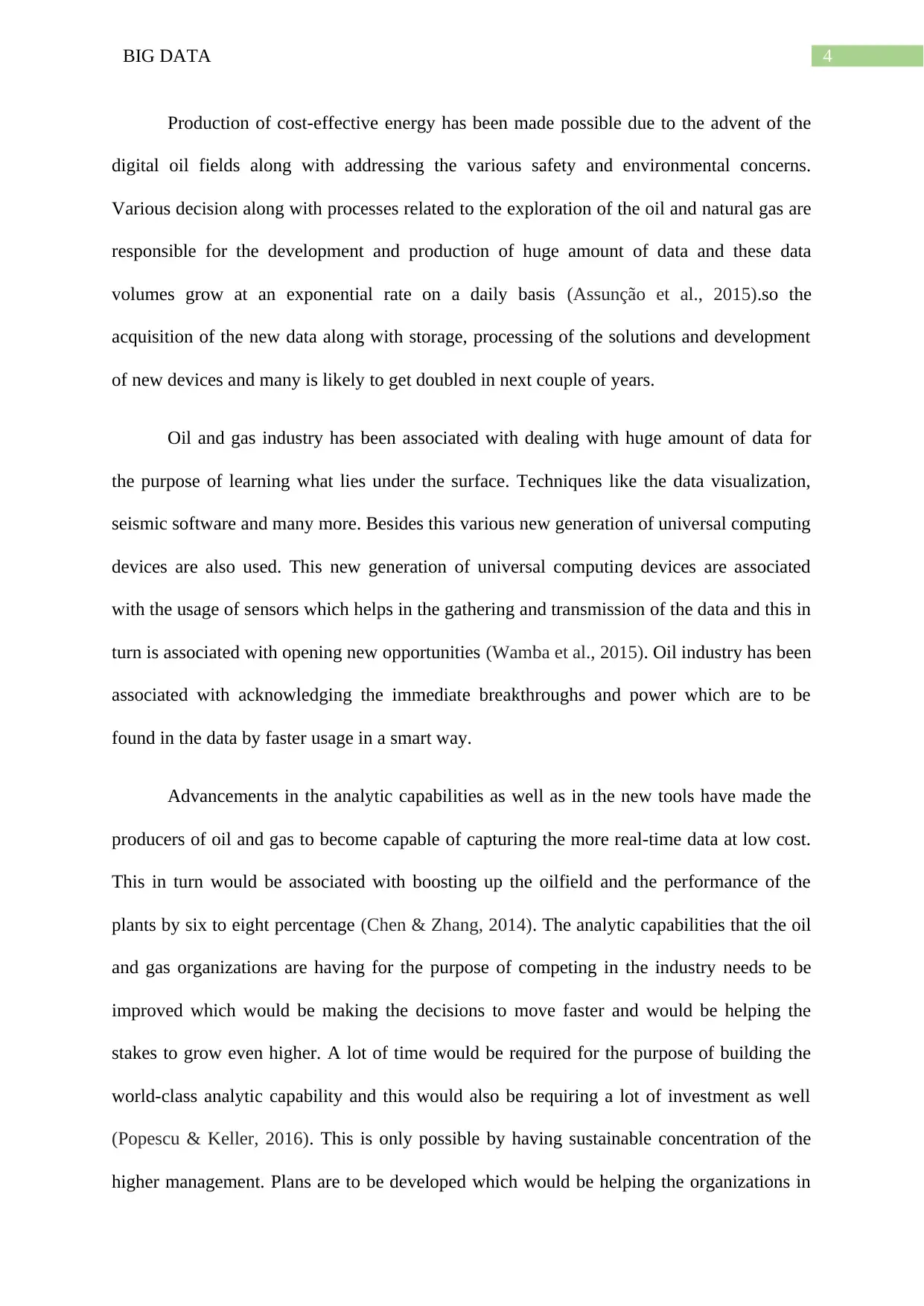
4BIG DATA
Production of cost-effective energy has been made possible due to the advent of the
digital oil fields along with addressing the various safety and environmental concerns.
Various decision along with processes related to the exploration of the oil and natural gas are
responsible for the development and production of huge amount of data and these data
volumes grow at an exponential rate on a daily basis (Assunção et al., 2015).so the
acquisition of the new data along with storage, processing of the solutions and development
of new devices and many is likely to get doubled in next couple of years.
Oil and gas industry has been associated with dealing with huge amount of data for
the purpose of learning what lies under the surface. Techniques like the data visualization,
seismic software and many more. Besides this various new generation of universal computing
devices are also used. This new generation of universal computing devices are associated
with the usage of sensors which helps in the gathering and transmission of the data and this in
turn is associated with opening new opportunities (Wamba et al., 2015). Oil industry has been
associated with acknowledging the immediate breakthroughs and power which are to be
found in the data by faster usage in a smart way.
Advancements in the analytic capabilities as well as in the new tools have made the
producers of oil and gas to become capable of capturing the more real-time data at low cost.
This in turn would be associated with boosting up the oilfield and the performance of the
plants by six to eight percentage (Chen & Zhang, 2014). The analytic capabilities that the oil
and gas organizations are having for the purpose of competing in the industry needs to be
improved which would be making the decisions to move faster and would be helping the
stakes to grow even higher. A lot of time would be required for the purpose of building the
world-class analytic capability and this would also be requiring a lot of investment as well
(Popescu & Keller, 2016). This is only possible by having sustainable concentration of the
higher management. Plans are to be developed which would be helping the organizations in
Production of cost-effective energy has been made possible due to the advent of the
digital oil fields along with addressing the various safety and environmental concerns.
Various decision along with processes related to the exploration of the oil and natural gas are
responsible for the development and production of huge amount of data and these data
volumes grow at an exponential rate on a daily basis (Assunção et al., 2015).so the
acquisition of the new data along with storage, processing of the solutions and development
of new devices and many is likely to get doubled in next couple of years.
Oil and gas industry has been associated with dealing with huge amount of data for
the purpose of learning what lies under the surface. Techniques like the data visualization,
seismic software and many more. Besides this various new generation of universal computing
devices are also used. This new generation of universal computing devices are associated
with the usage of sensors which helps in the gathering and transmission of the data and this in
turn is associated with opening new opportunities (Wamba et al., 2015). Oil industry has been
associated with acknowledging the immediate breakthroughs and power which are to be
found in the data by faster usage in a smart way.
Advancements in the analytic capabilities as well as in the new tools have made the
producers of oil and gas to become capable of capturing the more real-time data at low cost.
This in turn would be associated with boosting up the oilfield and the performance of the
plants by six to eight percentage (Chen & Zhang, 2014). The analytic capabilities that the oil
and gas organizations are having for the purpose of competing in the industry needs to be
improved which would be making the decisions to move faster and would be helping the
stakes to grow even higher. A lot of time would be required for the purpose of building the
world-class analytic capability and this would also be requiring a lot of investment as well
(Popescu & Keller, 2016). This is only possible by having sustainable concentration of the
higher management. Plans are to be developed which would be helping the organizations in
Paraphrase This Document
Need a fresh take? Get an instant paraphrase of this document with our AI Paraphraser
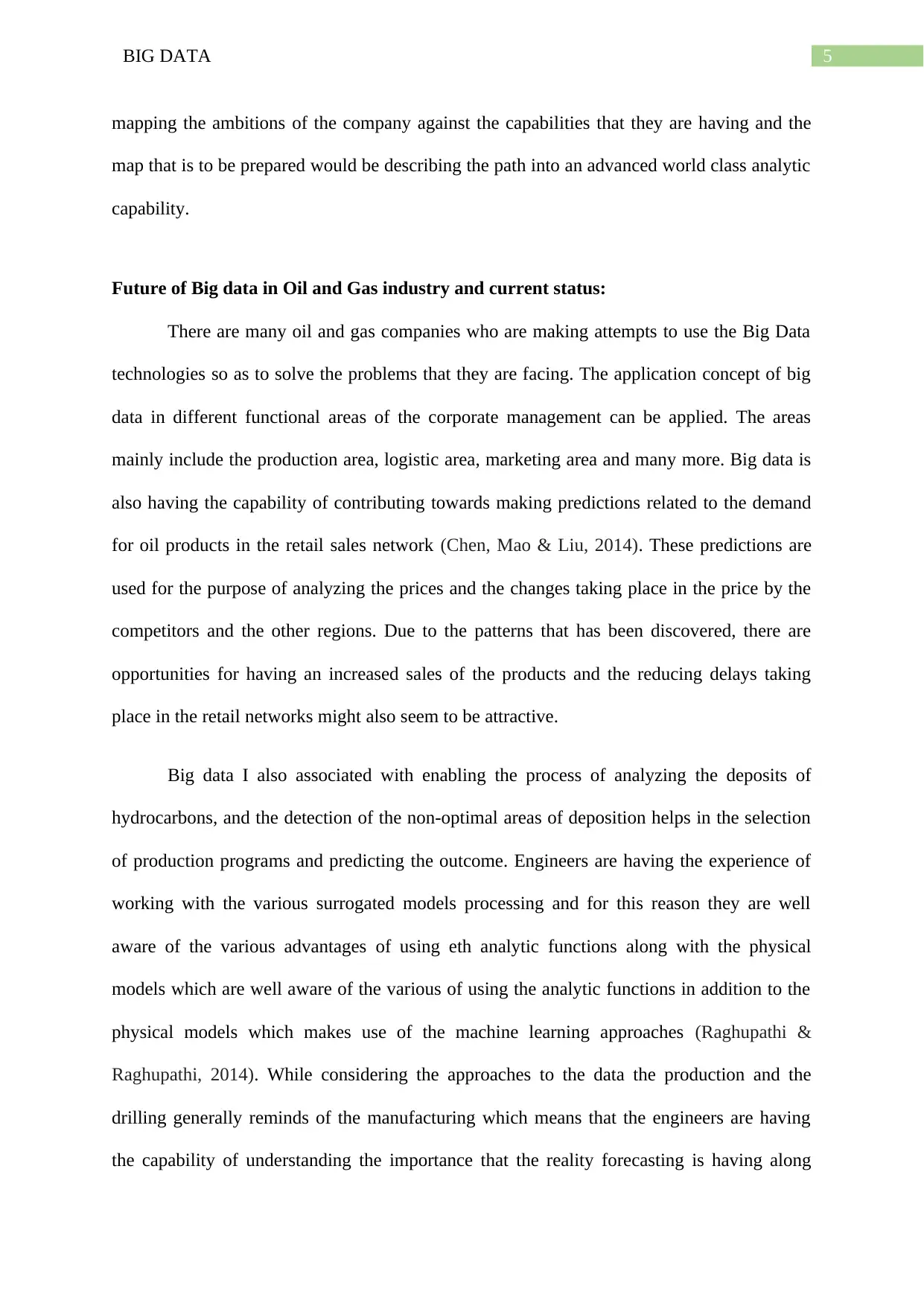
5BIG DATA
mapping the ambitions of the company against the capabilities that they are having and the
map that is to be prepared would be describing the path into an advanced world class analytic
capability.
Future of Big data in Oil and Gas industry and current status:
There are many oil and gas companies who are making attempts to use the Big Data
technologies so as to solve the problems that they are facing. The application concept of big
data in different functional areas of the corporate management can be applied. The areas
mainly include the production area, logistic area, marketing area and many more. Big data is
also having the capability of contributing towards making predictions related to the demand
for oil products in the retail sales network (Chen, Mao & Liu, 2014). These predictions are
used for the purpose of analyzing the prices and the changes taking place in the price by the
competitors and the other regions. Due to the patterns that has been discovered, there are
opportunities for having an increased sales of the products and the reducing delays taking
place in the retail networks might also seem to be attractive.
Big data I also associated with enabling the process of analyzing the deposits of
hydrocarbons, and the detection of the non-optimal areas of deposition helps in the selection
of production programs and predicting the outcome. Engineers are having the experience of
working with the various surrogated models processing and for this reason they are well
aware of the various advantages of using eth analytic functions along with the physical
models which are well aware of the various of using the analytic functions in addition to the
physical models which makes use of the machine learning approaches (Raghupathi &
Raghupathi, 2014). While considering the approaches to the data the production and the
drilling generally reminds of the manufacturing which means that the engineers are having
the capability of understanding the importance that the reality forecasting is having along
mapping the ambitions of the company against the capabilities that they are having and the
map that is to be prepared would be describing the path into an advanced world class analytic
capability.
Future of Big data in Oil and Gas industry and current status:
There are many oil and gas companies who are making attempts to use the Big Data
technologies so as to solve the problems that they are facing. The application concept of big
data in different functional areas of the corporate management can be applied. The areas
mainly include the production area, logistic area, marketing area and many more. Big data is
also having the capability of contributing towards making predictions related to the demand
for oil products in the retail sales network (Chen, Mao & Liu, 2014). These predictions are
used for the purpose of analyzing the prices and the changes taking place in the price by the
competitors and the other regions. Due to the patterns that has been discovered, there are
opportunities for having an increased sales of the products and the reducing delays taking
place in the retail networks might also seem to be attractive.
Big data I also associated with enabling the process of analyzing the deposits of
hydrocarbons, and the detection of the non-optimal areas of deposition helps in the selection
of production programs and predicting the outcome. Engineers are having the experience of
working with the various surrogated models processing and for this reason they are well
aware of the various advantages of using eth analytic functions along with the physical
models which are well aware of the various of using the analytic functions in addition to the
physical models which makes use of the machine learning approaches (Raghupathi &
Raghupathi, 2014). While considering the approaches to the data the production and the
drilling generally reminds of the manufacturing which means that the engineers are having
the capability of understanding the importance that the reality forecasting is having along
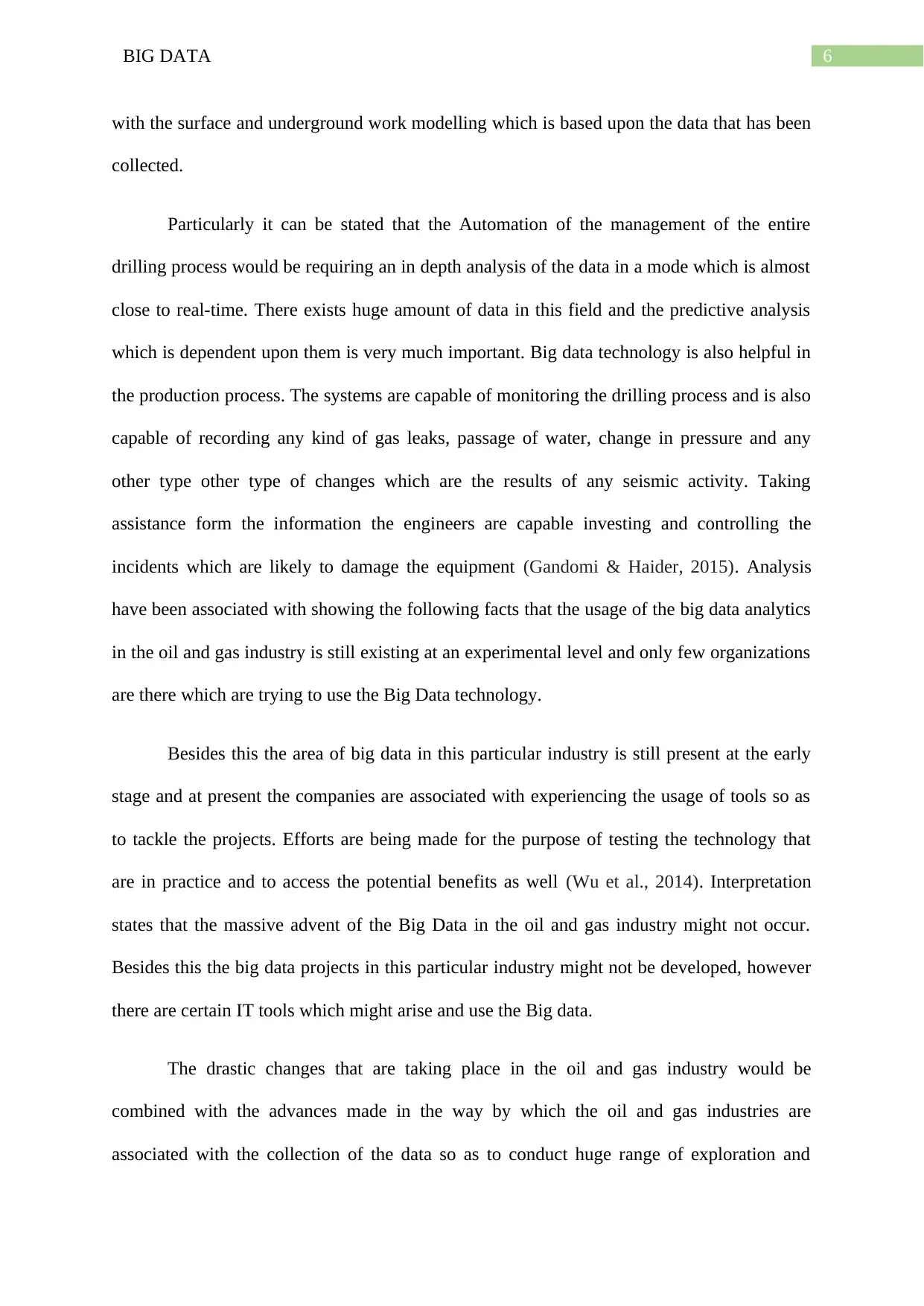
6BIG DATA
with the surface and underground work modelling which is based upon the data that has been
collected.
Particularly it can be stated that the Automation of the management of the entire
drilling process would be requiring an in depth analysis of the data in a mode which is almost
close to real-time. There exists huge amount of data in this field and the predictive analysis
which is dependent upon them is very much important. Big data technology is also helpful in
the production process. The systems are capable of monitoring the drilling process and is also
capable of recording any kind of gas leaks, passage of water, change in pressure and any
other type other type of changes which are the results of any seismic activity. Taking
assistance form the information the engineers are capable investing and controlling the
incidents which are likely to damage the equipment (Gandomi & Haider, 2015). Analysis
have been associated with showing the following facts that the usage of the big data analytics
in the oil and gas industry is still existing at an experimental level and only few organizations
are there which are trying to use the Big Data technology.
Besides this the area of big data in this particular industry is still present at the early
stage and at present the companies are associated with experiencing the usage of tools so as
to tackle the projects. Efforts are being made for the purpose of testing the technology that
are in practice and to access the potential benefits as well (Wu et al., 2014). Interpretation
states that the massive advent of the Big Data in the oil and gas industry might not occur.
Besides this the big data projects in this particular industry might not be developed, however
there are certain IT tools which might arise and use the Big data.
The drastic changes that are taking place in the oil and gas industry would be
combined with the advances made in the way by which the oil and gas industries are
associated with the collection of the data so as to conduct huge range of exploration and
with the surface and underground work modelling which is based upon the data that has been
collected.
Particularly it can be stated that the Automation of the management of the entire
drilling process would be requiring an in depth analysis of the data in a mode which is almost
close to real-time. There exists huge amount of data in this field and the predictive analysis
which is dependent upon them is very much important. Big data technology is also helpful in
the production process. The systems are capable of monitoring the drilling process and is also
capable of recording any kind of gas leaks, passage of water, change in pressure and any
other type other type of changes which are the results of any seismic activity. Taking
assistance form the information the engineers are capable investing and controlling the
incidents which are likely to damage the equipment (Gandomi & Haider, 2015). Analysis
have been associated with showing the following facts that the usage of the big data analytics
in the oil and gas industry is still existing at an experimental level and only few organizations
are there which are trying to use the Big Data technology.
Besides this the area of big data in this particular industry is still present at the early
stage and at present the companies are associated with experiencing the usage of tools so as
to tackle the projects. Efforts are being made for the purpose of testing the technology that
are in practice and to access the potential benefits as well (Wu et al., 2014). Interpretation
states that the massive advent of the Big Data in the oil and gas industry might not occur.
Besides this the big data projects in this particular industry might not be developed, however
there are certain IT tools which might arise and use the Big data.
The drastic changes that are taking place in the oil and gas industry would be
combined with the advances made in the way by which the oil and gas industries are
associated with the collection of the data so as to conduct huge range of exploration and
⊘ This is a preview!⊘
Do you want full access?
Subscribe today to unlock all pages.

Trusted by 1+ million students worldwide
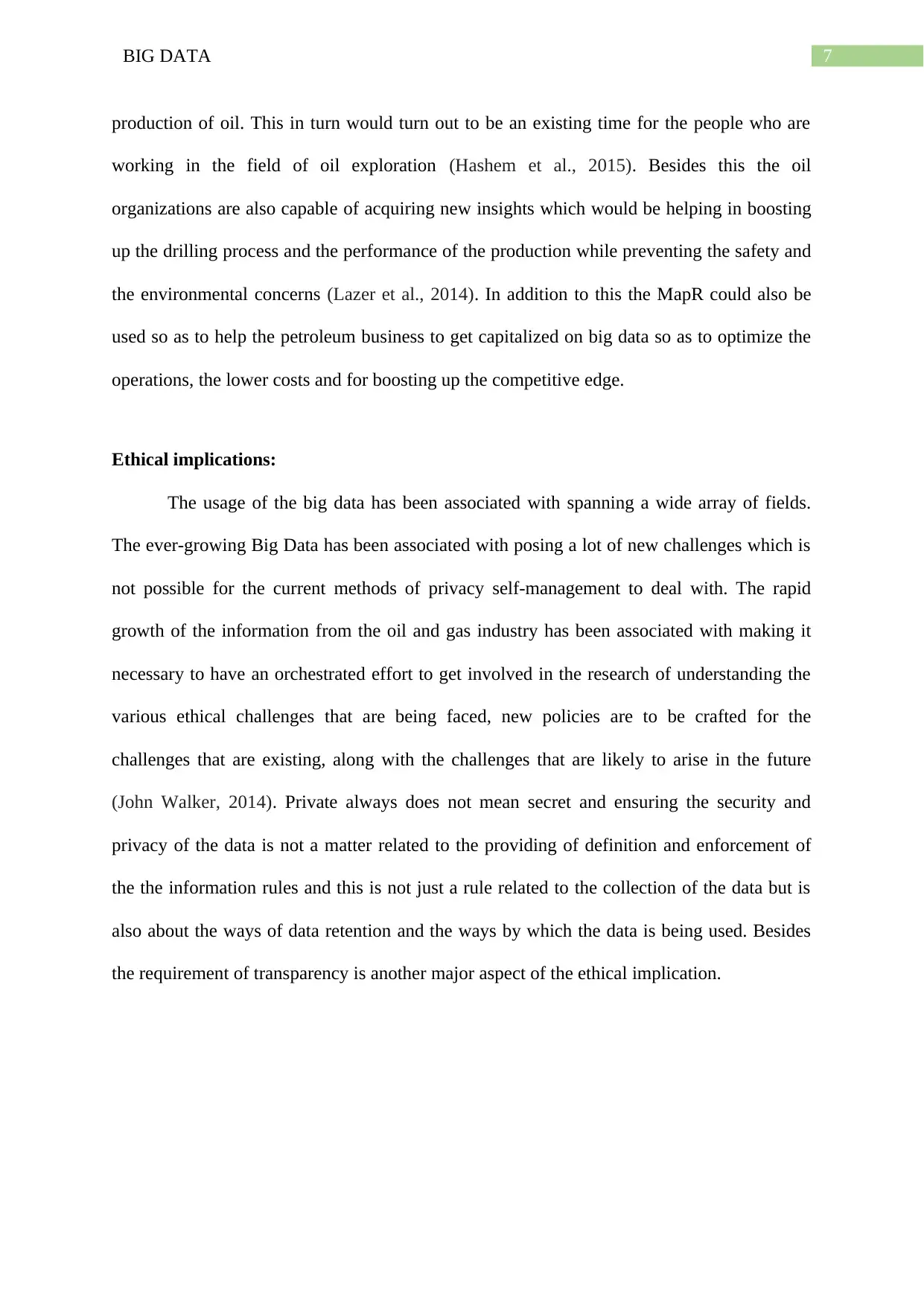
7BIG DATA
production of oil. This in turn would turn out to be an existing time for the people who are
working in the field of oil exploration (Hashem et al., 2015). Besides this the oil
organizations are also capable of acquiring new insights which would be helping in boosting
up the drilling process and the performance of the production while preventing the safety and
the environmental concerns (Lazer et al., 2014). In addition to this the MapR could also be
used so as to help the petroleum business to get capitalized on big data so as to optimize the
operations, the lower costs and for boosting up the competitive edge.
Ethical implications:
The usage of the big data has been associated with spanning a wide array of fields.
The ever-growing Big Data has been associated with posing a lot of new challenges which is
not possible for the current methods of privacy self-management to deal with. The rapid
growth of the information from the oil and gas industry has been associated with making it
necessary to have an orchestrated effort to get involved in the research of understanding the
various ethical challenges that are being faced, new policies are to be crafted for the
challenges that are existing, along with the challenges that are likely to arise in the future
(John Walker, 2014). Private always does not mean secret and ensuring the security and
privacy of the data is not a matter related to the providing of definition and enforcement of
the the information rules and this is not just a rule related to the collection of the data but is
also about the ways of data retention and the ways by which the data is being used. Besides
the requirement of transparency is another major aspect of the ethical implication.
production of oil. This in turn would turn out to be an existing time for the people who are
working in the field of oil exploration (Hashem et al., 2015). Besides this the oil
organizations are also capable of acquiring new insights which would be helping in boosting
up the drilling process and the performance of the production while preventing the safety and
the environmental concerns (Lazer et al., 2014). In addition to this the MapR could also be
used so as to help the petroleum business to get capitalized on big data so as to optimize the
operations, the lower costs and for boosting up the competitive edge.
Ethical implications:
The usage of the big data has been associated with spanning a wide array of fields.
The ever-growing Big Data has been associated with posing a lot of new challenges which is
not possible for the current methods of privacy self-management to deal with. The rapid
growth of the information from the oil and gas industry has been associated with making it
necessary to have an orchestrated effort to get involved in the research of understanding the
various ethical challenges that are being faced, new policies are to be crafted for the
challenges that are existing, along with the challenges that are likely to arise in the future
(John Walker, 2014). Private always does not mean secret and ensuring the security and
privacy of the data is not a matter related to the providing of definition and enforcement of
the the information rules and this is not just a rule related to the collection of the data but is
also about the ways of data retention and the ways by which the data is being used. Besides
the requirement of transparency is another major aspect of the ethical implication.
Paraphrase This Document
Need a fresh take? Get an instant paraphrase of this document with our AI Paraphraser
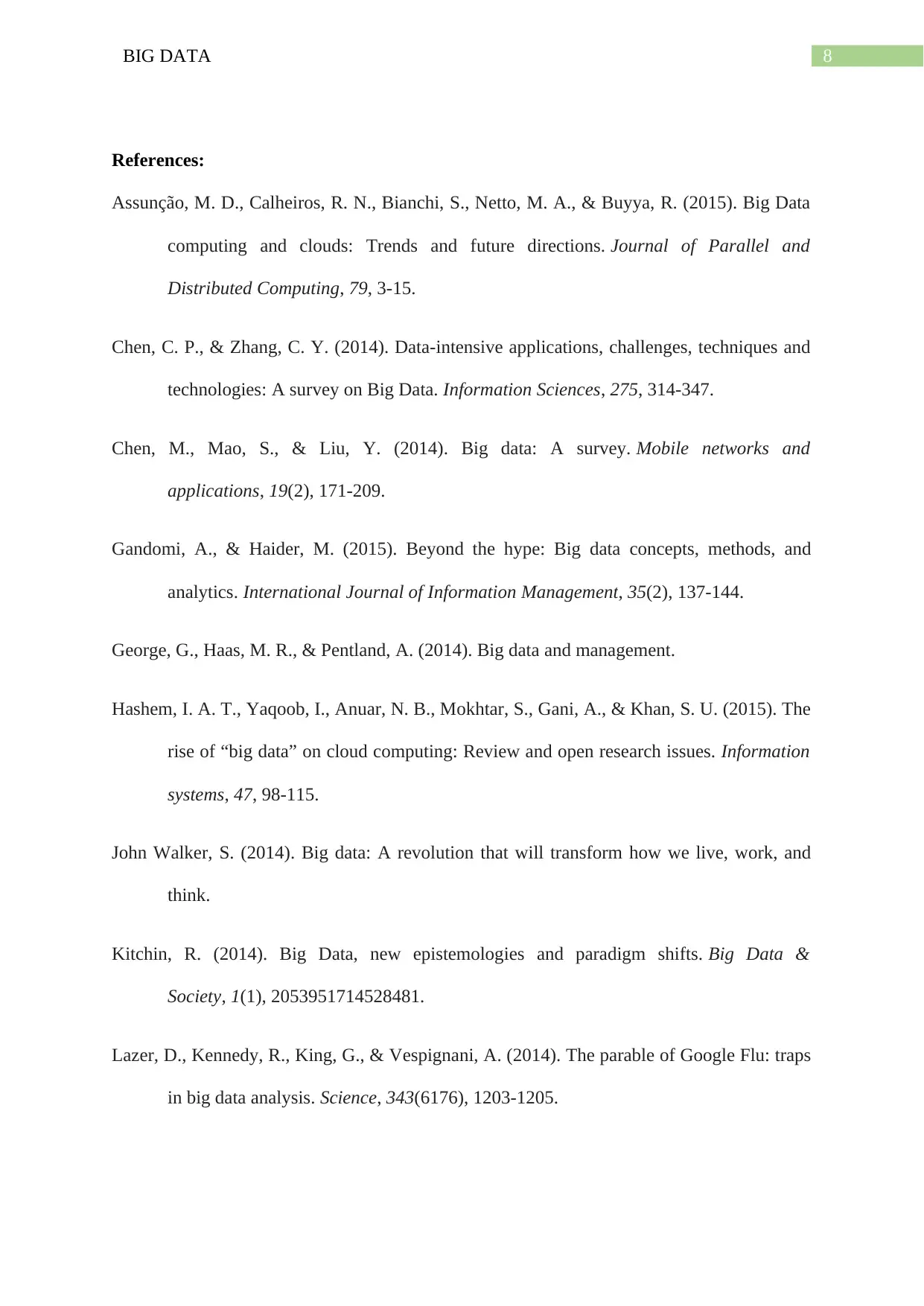
8BIG DATA
References:
Assunção, M. D., Calheiros, R. N., Bianchi, S., Netto, M. A., & Buyya, R. (2015). Big Data
computing and clouds: Trends and future directions. Journal of Parallel and
Distributed Computing, 79, 3-15.
Chen, C. P., & Zhang, C. Y. (2014). Data-intensive applications, challenges, techniques and
technologies: A survey on Big Data. Information Sciences, 275, 314-347.
Chen, M., Mao, S., & Liu, Y. (2014). Big data: A survey. Mobile networks and
applications, 19(2), 171-209.
Gandomi, A., & Haider, M. (2015). Beyond the hype: Big data concepts, methods, and
analytics. International Journal of Information Management, 35(2), 137-144.
George, G., Haas, M. R., & Pentland, A. (2014). Big data and management.
Hashem, I. A. T., Yaqoob, I., Anuar, N. B., Mokhtar, S., Gani, A., & Khan, S. U. (2015). The
rise of “big data” on cloud computing: Review and open research issues. Information
systems, 47, 98-115.
John Walker, S. (2014). Big data: A revolution that will transform how we live, work, and
think.
Kitchin, R. (2014). Big Data, new epistemologies and paradigm shifts. Big Data &
Society, 1(1), 2053951714528481.
Lazer, D., Kennedy, R., King, G., & Vespignani, A. (2014). The parable of Google Flu: traps
in big data analysis. Science, 343(6176), 1203-1205.
References:
Assunção, M. D., Calheiros, R. N., Bianchi, S., Netto, M. A., & Buyya, R. (2015). Big Data
computing and clouds: Trends and future directions. Journal of Parallel and
Distributed Computing, 79, 3-15.
Chen, C. P., & Zhang, C. Y. (2014). Data-intensive applications, challenges, techniques and
technologies: A survey on Big Data. Information Sciences, 275, 314-347.
Chen, M., Mao, S., & Liu, Y. (2014). Big data: A survey. Mobile networks and
applications, 19(2), 171-209.
Gandomi, A., & Haider, M. (2015). Beyond the hype: Big data concepts, methods, and
analytics. International Journal of Information Management, 35(2), 137-144.
George, G., Haas, M. R., & Pentland, A. (2014). Big data and management.
Hashem, I. A. T., Yaqoob, I., Anuar, N. B., Mokhtar, S., Gani, A., & Khan, S. U. (2015). The
rise of “big data” on cloud computing: Review and open research issues. Information
systems, 47, 98-115.
John Walker, S. (2014). Big data: A revolution that will transform how we live, work, and
think.
Kitchin, R. (2014). Big Data, new epistemologies and paradigm shifts. Big Data &
Society, 1(1), 2053951714528481.
Lazer, D., Kennedy, R., King, G., & Vespignani, A. (2014). The parable of Google Flu: traps
in big data analysis. Science, 343(6176), 1203-1205.
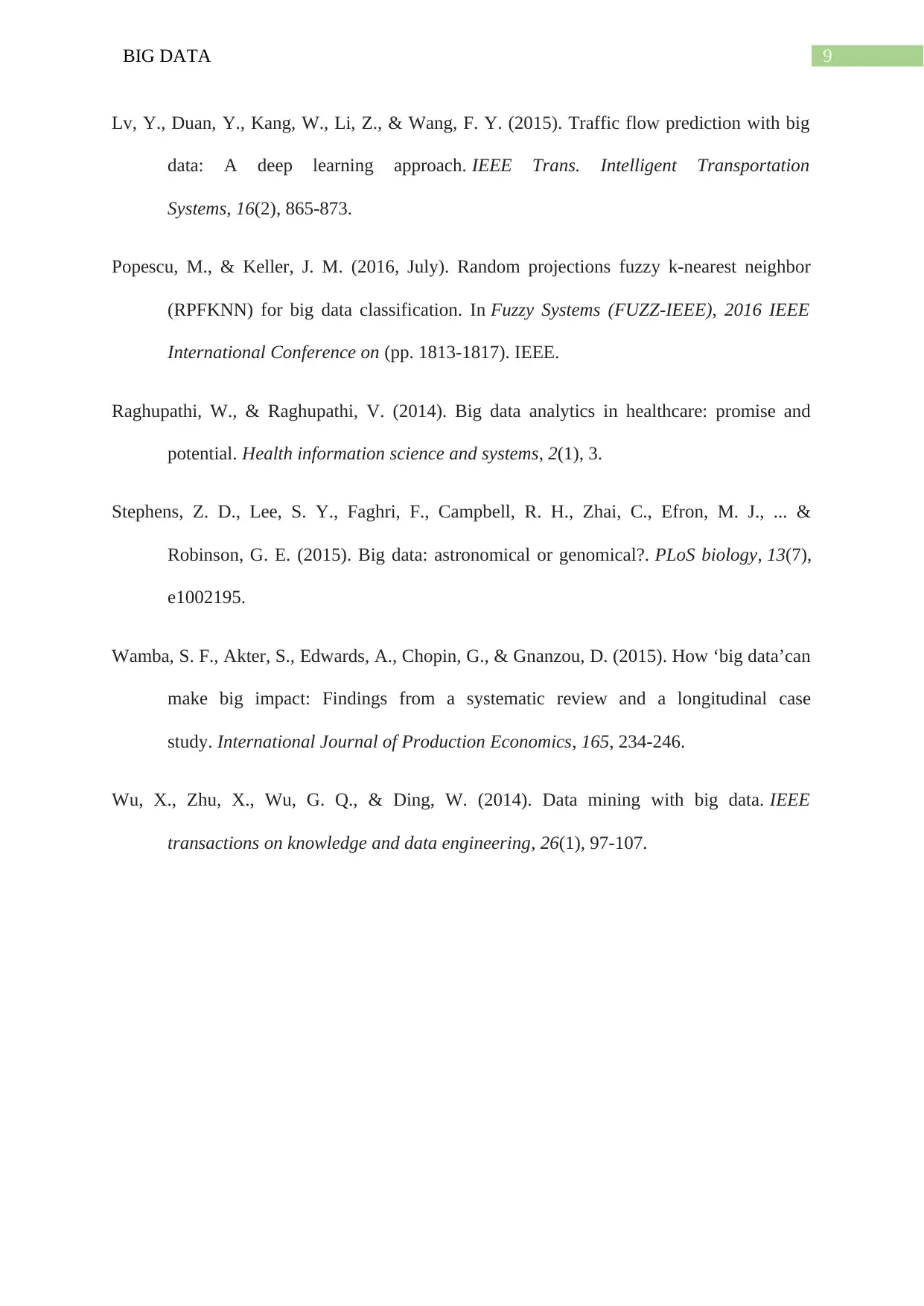
9BIG DATA
Lv, Y., Duan, Y., Kang, W., Li, Z., & Wang, F. Y. (2015). Traffic flow prediction with big
data: A deep learning approach. IEEE Trans. Intelligent Transportation
Systems, 16(2), 865-873.
Popescu, M., & Keller, J. M. (2016, July). Random projections fuzzy k-nearest neighbor
(RPFKNN) for big data classification. In Fuzzy Systems (FUZZ-IEEE), 2016 IEEE
International Conference on (pp. 1813-1817). IEEE.
Raghupathi, W., & Raghupathi, V. (2014). Big data analytics in healthcare: promise and
potential. Health information science and systems, 2(1), 3.
Stephens, Z. D., Lee, S. Y., Faghri, F., Campbell, R. H., Zhai, C., Efron, M. J., ... &
Robinson, G. E. (2015). Big data: astronomical or genomical?. PLoS biology, 13(7),
e1002195.
Wamba, S. F., Akter, S., Edwards, A., Chopin, G., & Gnanzou, D. (2015). How ‘big data’can
make big impact: Findings from a systematic review and a longitudinal case
study. International Journal of Production Economics, 165, 234-246.
Wu, X., Zhu, X., Wu, G. Q., & Ding, W. (2014). Data mining with big data. IEEE
transactions on knowledge and data engineering, 26(1), 97-107.
Lv, Y., Duan, Y., Kang, W., Li, Z., & Wang, F. Y. (2015). Traffic flow prediction with big
data: A deep learning approach. IEEE Trans. Intelligent Transportation
Systems, 16(2), 865-873.
Popescu, M., & Keller, J. M. (2016, July). Random projections fuzzy k-nearest neighbor
(RPFKNN) for big data classification. In Fuzzy Systems (FUZZ-IEEE), 2016 IEEE
International Conference on (pp. 1813-1817). IEEE.
Raghupathi, W., & Raghupathi, V. (2014). Big data analytics in healthcare: promise and
potential. Health information science and systems, 2(1), 3.
Stephens, Z. D., Lee, S. Y., Faghri, F., Campbell, R. H., Zhai, C., Efron, M. J., ... &
Robinson, G. E. (2015). Big data: astronomical or genomical?. PLoS biology, 13(7),
e1002195.
Wamba, S. F., Akter, S., Edwards, A., Chopin, G., & Gnanzou, D. (2015). How ‘big data’can
make big impact: Findings from a systematic review and a longitudinal case
study. International Journal of Production Economics, 165, 234-246.
Wu, X., Zhu, X., Wu, G. Q., & Ding, W. (2014). Data mining with big data. IEEE
transactions on knowledge and data engineering, 26(1), 97-107.
⊘ This is a preview!⊘
Do you want full access?
Subscribe today to unlock all pages.

Trusted by 1+ million students worldwide
1 out of 9
Related Documents
Your All-in-One AI-Powered Toolkit for Academic Success.
+13062052269
info@desklib.com
Available 24*7 on WhatsApp / Email
![[object Object]](/_next/static/media/star-bottom.7253800d.svg)
Unlock your academic potential
Copyright © 2020–2025 A2Z Services. All Rights Reserved. Developed and managed by ZUCOL.



